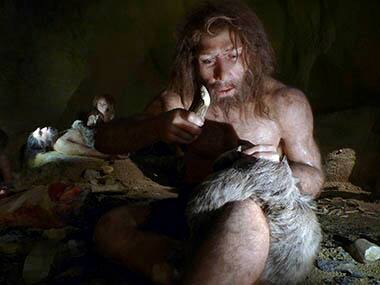New York: It’s getting harder and harder to take umbrage if someone calls you a Neanderthal. According to two studies published on Wednesday, DNA from these pre-modern humans may play a role in the appearance of hair and skin as well as the risk of certain diseases. Although Neanderthals became extinct 28,000 years ago in Europe, as much as one-fifth of their DNA has survived in human genomes due to interbreeding tens of thousands of years ago, one of the studies found, although any one individual has only about 2 percent of caveman DNA. [caption id=“attachment_1365841” align=“alignleft” width=“380”]  An exhibit shows the life of a Neanderthal family in a cave in the new Neanderthal Museum in the northern town of Krapina. Reuters[/caption] “The 2 percent of your Neanderthal DNA might be different than my 2 percent of Neanderthal DNA, and it’s found at different places in the genome,” said geneticist Joshua Akey, who led one of the studies. Put it all together in a study of hundreds of people, and “you can recover a substantial proportion of the Neanderthal genome.” Both studies confirmed earlier findings that the genomes of east Asians harbor more Neanderthal DNA than those of Europeans. This could be 21 percent more, according to an analysis by Akey and Benjamin Vernot, published online in the journal Science. Still, “more” is a relative term. According to the paper by geneticists at Harvard Medical School, published in Nature, about 1.4 percent of the genomes of Han Chinese in Beijing and south China, as well as Japanese in Tokyo come from Neanderthals, compared to 1.1 percent of the genomes of Europeans. Anthropologists expressed caution about the findings. Fewer than half a dozen Neanderthal fossils have yielded genetic material, said Erik Trinkaus of Washington University in St. Louis, one of the world’s leading experts on early humans. Using this small sample to infer how much Neanderthal DNA persists in today’s genome is therefore questionable, he said. INTERBREEDING As expected, since Neanderthals never existed in Africa, Africans and those who trace their ancestry to that continent have almost no Neanderthal DNA, the Harvard team found. Human ancestors began migrating out of humanity’s natal continent as early as 1 million years ago, paleoanthropologists infer from fossil evidence, and between 500,000 and 200,000 years ago evolved into the robust, large-browed Homo neanderthalensis in Western Europe. Ever since scientists extracted DNA from the remains of Neanderthals, they have known that people today carry snippets of cavemen genes, in the amounts of 2 percent to 3 percent. That clinched the case that Neanderthals and modern humans interbred, probably 40,000 to 80,000 years ago, soon after the latter arrived in Europe from Africa. The new studies add details about how much DNA and of what kind we inherited. “The story of early human evolution is captivating in itself, yet it also has far-reaching implications for understanding the organization of the modern human genome,” Irene Eckstrand of the National Institutes of Health’s National Institute of General Medical Sciences, which partially funded the research, said in a statement. “Every piece of this story that we uncover tells us more about our ancestors’ genetic contributions to modern human health and disease.” DISEASES The Harvard team used a novel genetic algorithm to estimate the probability that a particular genetic variant arose from Neanderthals. Basically, they started with the genome of a 50,000-year-old Neanderthal, and determined whether pieces of it also appeared in some non-Africans but not in sub-Saharan Africans. The algorithm identified remnants of Neanderthal DNA, called alleles, in genes associated with type 2 diabetes, Crohn’s disease, lupus, biliary cirrhosis and smoking behavior. “But we can’t tell if the Neanderthal alleles are contributing to disease,” said Harvard’s Sriram Sankararaman, lead author of the paper in Nature. Areas “with increased Neanderthal ancestry tend to be higher the farther away you go from genes,” sitting, instead, in regions of the genome that do not actually produce the proteins, enzymes and other working molecules of the body. Neanderthal DNA does sit within some genes, however, such as those for keratin, a fibrous protein that makes skin, hair and nails tough and can be beneficial in colder environments by providing thicker insulation. The endurance of this Neanderthal DNA suggests that our caveman inheritance was adaptive, picked by natural selection to persist in our genome, generation after generation, because it conferred a survival advantage in individuals who carried it. SPEECH The Harvard team analyzed the genomes of 1,004 people to estimate which populations got more or fewer Neanderthal DNA. Confirming a 2013 study, they found more in the genomes of east Asians than in Europeans. But they also dug deeper. Puerto Ricans and Spaniards have the least Neanderthal DNA, 1.05 percent and 1.07 percent respectively. That is curious because Neanderthals made their last stand on the Iberian peninsula, finally dying out there 28,000 years ago. Across all populations, Neanderthal DNA is conspicuously low in regions of the X chromosome and in testes-specific genes. The paucity of Neanderthal genes among those active in the testes suggests that interbreeding wasn’t a resounding success: It produced viable children, but the males were infertile. Although as much as 20 percent of Neanderthal DNA persists in modern genomes, according to the Washington scientists, vast regions of the latter are Neanderthal deserts. Among them is a region of chromosome 7 that includes a gene called FOXP2. “FOXP2 has previously been implicated in speech and language and may be an example of a gene that influences a uniquely human trait, which is why we find no Neanderthal sequences in these regions,” said Akey. Reuters
According to two studies published on Wednesday, DNA from these pre-modern humans may play a role in the appearance of hair and skin as well as the risk of certain diseases.
Advertisement
End of Article
Written by FP Archives
see more


)

)
)
)
)
)
)
)
)



